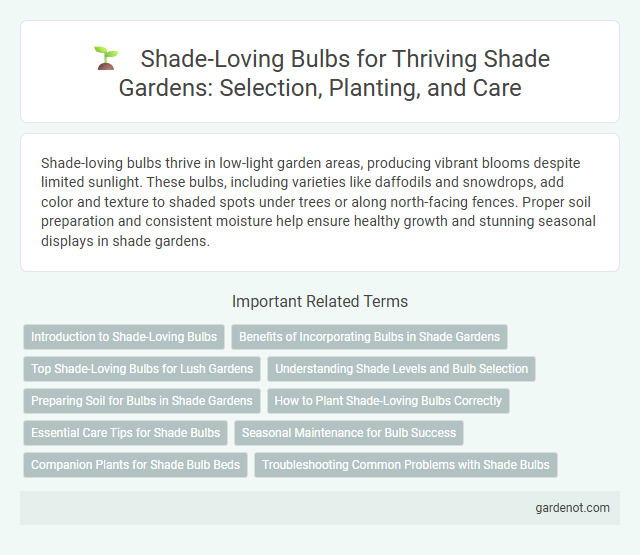Shade-loving bulbs thrive in low-light garden areas, producing vibrant blooms despite limited sunlight. These bulbs, including varieties like daffodils and snowdrops, add color and texture to shaded spots under trees or along north-facing fences. Proper soil preparation and consistent moisture help ensure healthy growth and stunning seasonal displays in shade gardens.
Introduction to Shade-Loving Bulbs
Shade-loving bulbs thrive in low-light garden areas, bringing vibrant color and texture to spaces where many other plants struggle. Common varieties include snowdrops, cyclamen, and autumn crocus, each adapted to bloom beautifully under tree canopies or shaded borders. These bulbs require well-drained soil and consistent moisture to flourish throughout the growing season.
Benefits of Incorporating Bulbs in Shade Gardens
Shade-loving bulbs such as snowdrops, lilies of the valley, and bluebells bring early spring color and texture to shaded garden areas where many plants struggle to thrive. Incorporating these bulbs enhances biodiversity by attracting pollinators like bees and butterflies, which supports a healthier garden ecosystem. These low-maintenance bulbs improve soil structure with their root systems and provide seasonal interest that complements shade-loving perennials and ferns.
Top Shade-Loving Bulbs for Lush Gardens
Top shade-loving bulbs such as snowdrops, colchicum, and anemones thrive in low-light environments, adding vibrant color and texture to shaded garden areas. These bulbs require well-drained soil and moderate moisture to flourish under tree canopies or north-facing borders. Incorporating shade-tolerant bulbs ensures year-round interest and lush growth even in gardens with limited sunlight.
Understanding Shade Levels and Bulb Selection
Shade-loving bulbs thrive in varying shade levels, from light dappled shade to deep, dense shade, making it crucial to assess the garden's specific light conditions. Selecting bulbs such as snowdrops, bluebells, and fritillaries, which are adapted to lower light environments, ensures successful growth and vibrant blooms. Understanding the spectrum of shade--partial, filtered, or full shade--allows gardeners to match bulb species with optimal conditions, enhancing plant health and garden aesthetics.
Preparing Soil for Bulbs in Shade Gardens
To prepare soil for shade-loving bulbs in shade gardens, ensure it is well-draining yet rich in organic matter such as compost or leaf mold to retain moisture without waterlogging. Loosen the soil to a depth of at least 8 to 10 inches to facilitate root penetration and improve aeration. Maintain a slightly acidic to neutral pH, ideally between 6.0 and 7.0, to optimize nutrient availability for bulbs like snowdrops, colchicum, and anemones.
How to Plant Shade-Loving Bulbs Correctly
Plant shade-loving bulbs like snowdrops and colchicums in well-drained soil enriched with organic matter to ensure healthy growth in low-light conditions. Position bulbs at a depth of two to three times their size and space them adequately to allow air circulation, reducing the risk of rot and disease. Water the planted bulbs thoroughly after planting and mulch to retain moisture and regulate soil temperature in shaded garden areas.
Essential Care Tips for Shade Bulbs
Shade-loving bulbs such as snowdrops, lilies of the valley, and anemones thrive in minimal sunlight and require consistently moist, well-drained soil enriched with organic matter. Regular watering during dry spells and mulching helps retain soil moisture and regulate temperature, essential for healthy bulb growth. Avoid overcrowding bulbs to ensure proper air circulation and reduce the risk of fungal diseases, supporting vibrant blooms in low-light garden areas.
Seasonal Maintenance for Bulb Success
Shade-loving bulbs such as snowdrops, bluebells, and cyclamen require careful seasonal maintenance to thrive in shaded gardens. During the growing season, ensure bulbs receive adequate moisture while avoiding waterlogging to prevent rot and promote strong root development. After flowering, allow foliage to die back naturally to replenish bulb energy for the next season's bloom, and apply a layer of mulch in late fall to protect bulbs from extreme cold.
Companion Plants for Shade Bulb Beds
Shade-loving bulbs such as snowdrops, bluebells, and cyclamen thrive in low-light conditions and benefit from companion plants like hostas, ferns, and astilbes that enhance soil moisture retention and provide complementary foliage textures. Selecting shade-tolerant perennials with varying heights and bloom times creates a dynamic and layered garden bed, improving both aesthetic appeal and plant health. Combining these plants ensures a sustainable ecosystem by attracting pollinators and supporting beneficial insects, boosting overall shade garden vitality.
Troubleshooting Common Problems with Shade Bulbs
Shade-loving bulbs often face challenges like rot and poor growth due to excessive moisture and inadequate soil drainage. Ensuring well-drained, humus-rich soil with consistent but moderate watering prevents fungal infections and bulb decay. Monitoring for pests such as slugs and adjusting light exposure can improve bloom quality and bulb health in low-light garden areas.
Shade-loving bulb Infographic

 gardenot.com
gardenot.com